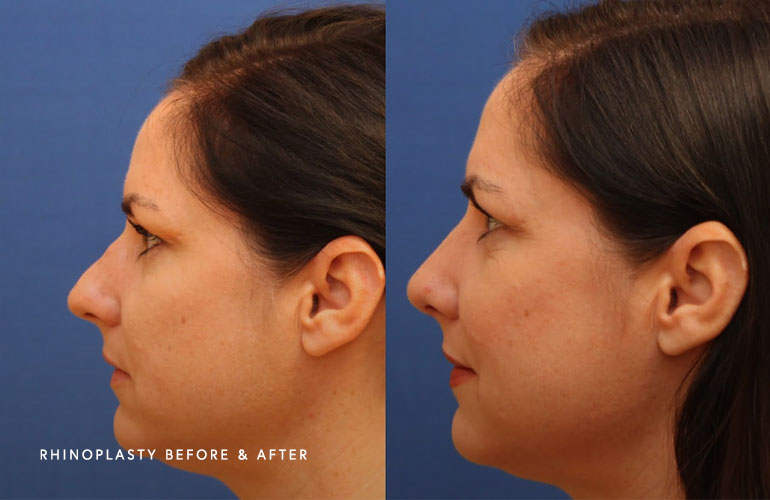Nose Job (Rhinoplasty)
Rhinoplasty
Nose reshaping is performed for both cosmetic as well as functional concerns. Rhinoplasty is done to correct distracting features of a nose and/or to improve breathing. The nose lies centrally, unlike other parts of our body and face. Therefore, even slight asymmetries in the nose can be immediately apparent. The goal of a rhinoplasty or revision rhinoplasty should be to eliminate a distraction so that the other more aesthetically pleasing facial features become more noticeable. Because rhinoplasty can improve (or worsen) breathing, it is important that the patient seeks a surgeon who is specially trained in facial cosmetic procedures and understands the intricacies of nasal anatomy.
There are several approaches to reshaping the nose during rhinoplasty surgery. The majority of incisions are made inside the nose, where they are invisible. In certain cases, the incision will be made in the skin separating the nostrils. Following the first incision, the skin is lifted and nasal cartilage and bone are manipulated to create a well-defined, proportionate shape, then the skin is re-draped over the new frame and the incisions are closed. To aid in the healing process, a nasal splint is applied to maintain the new shape. Additional soft materials may be put inside the nose to support the new structure and protect the air passages.
Recovery
Dr. Blanks’ technique requires no packing of the nose and one week after your rhinoplasty procedure, your surgeon will remove your splints. It is important that you follow your surgeon’s directions, especially instructions to keep your head elevated and to refrain from blowing your nose following surgery.

Revision Rhinoplasty
Purpose
Unfortunately, patients are sometimes left with a noticeable defect after rhinoplasty that must be surgically corrected and then a specialist is truly desired. This includes both cosmetic defects as well as breathing issues. The defect may be subtle or colossal. Communication between the patient and surgeon is essential to determine mutual and realistic goals of the surgery. Dr. Blanks has vast experience with revision rhinoplasty and has written on the subject for various texts and journals. It is best to bring to your consultation all of your before and after photos and operative notes from your prior procedure(s).
Procedure
When evaluating the nose, the plastic surgeon must take into account the overall size and shape of the face, lips, and chin. Dr. Blanks also assesses the internal structures of the nose that affect breathing. In addition to correcting the shape of the nose, she will correct any internal abnormalities to optimize breathing. In revision rhinoplasty, it is often necessary to provide additional structure and shape to the nose. This can usually be achieved using the patient’s own cartilage from the nose. In severe cases, it may be necessary to use cartilage from the ear or ribs or use a synthetic biocompatible implant. Rhinoplasty can be performed via various approaches. The majority, if not the entirety, of the incisions are placed inside the nose to hide them. The bone and cartilage of the nose is then reshaped to optimize the length, profile, and symmetry. Additionally, harmony with the lips and chin is achieved. Dr. Blanks may recommend additional procedures, such as a chin augmentation, to complement the revision rhinoplasty and provide the best results. The length of the procedure can vary from 1-4 hrs, depending on degree of irregularity. It can be performed under local anesthesia, conscious sedation, or general anesthesia. Together with Dr. Blanks, the appropriate anesthetic plan will be determined.
Recovery
Most patients will feel up to returning to work within 3-5 days of surgery. At the time of surgery, a small splint is placed over the nose for protection. This is removed within 7 days of surgery. You will be asked to sleep on your back for a few weeks to avoid injuring the nose. Nose blowing must also be avoided for at least 4 weeks after surgery. Bruising around the eyes may occur in cases when the nose must be straightened and generally disappears within 2 weeks. No sutures will need to be removed as they all disappear on their own.
Septoplasty
Purpose
The nose is divided internally into two sides by our nasal septum. The septum consists of both cartilage and bone. When the septum is crooked or deviated it can lead to breathing problems on one or both sides of our nose. This can be genetic or the result of a previous surgery or nasal trauma. Surgical removal of the crooked portions and straightening of the septum is necessary to improve breathing. In addition, creating a straight septum can often correct a crooked appearing nose.
Procedure
The incision is placed inside the nose and is completely hidden. The crooked and deviated portions of the septum are removed. These can often be straightened and placed back into their natural position should the patient ever require cartilage grafts in the future for a rhinoplasty. The incision is then closed. Unlike the days of old, no packing is required within the nose itself. The procedure is performed with general anesthesia to keep the patient comfortable. The procedure generally lasts 45 minutes or less.
Recovery
The patient can expect to return to work within a few days. There is generally minimal swelling around the nose for a couple of days. Nose blowing is to be avoided for at least 4 weeks after surgery. All sutures dissolve on their own.


 / 103 Reviews
/ 103 Reviews